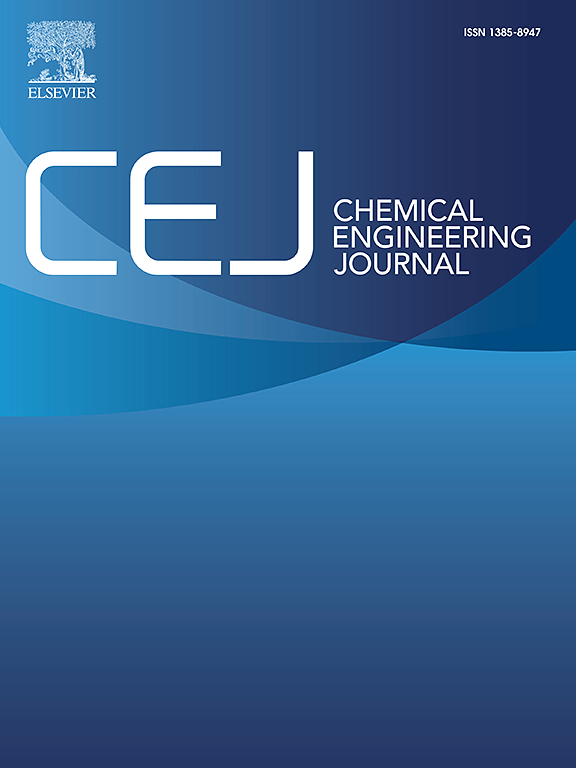通过Ru-d定制工程平衡OOH吸附和RuO共价,促进酸性水氧化
IF 13.2
1区 工程技术
Q1 ENGINEERING, CHEMICAL
引用次数: 0
摘要
研究钌氧化物(RuO2)基催化剂机理转变的机理调控策略和参数对增强酸性析氧反应(OER)至关重要。本文以MRuOx (M = W, Ce, Mn, Ti, Hf和Zr)化合物为模型,重点通过微调Ru-d波段中心来调节*OOH吸附和RuO共价,从而定制OER机制转变。通过密度泛函理论(DFT)计算和实验结果的综合分析,可以得出随着Ru-d带中心逐渐减小,*OOH吸附和RuO共价逐渐减弱的结论。最佳的催化性能出现时,*OOH吸附达到峰值,同时保持不活跃的晶格氧。所筛选的Ce0.75Ru0.25O2催化剂在吸附演化机制(AEM)中具有最大*OOH结合能,具有最佳的OER活性和稳定性。使用该催化剂的可扩展质子交换膜电解槽(PEMWE)单电池仅需1.60 V即可达到1 A cm - 2,并且具有超过2000 h的卓越稳定性。本文章由计算机程序翻译,如有差异,请以英文原文为准。


Balancing *OOH adsorption and RuO covalency via Ru-d customized engineering to boosted acidic water oxidation
Developing a mechanistic regulation strategy and parameter for mechanism transition on ruthenium oxides (RuO2)-based catalysts is essential for enhanced acidic oxygen evolution reaction (OER). Herein, employing MRuOx (M = W, Ce, Mn, Ti, Hf and Zr) compounds as model, we focus on fine-tuning Ru-d band center to adjust *OOH adsorption and Ru![]() O covalency, thereby customizing OER mechanism transition. Through integrated analysis of density functional theory (DFT) calculations and experimental results, it can be concluded that as Ru-d band center gradually decreases, the *OOH adsorption and Ru
O covalency, thereby customizing OER mechanism transition. Through integrated analysis of density functional theory (DFT) calculations and experimental results, it can be concluded that as Ru-d band center gradually decreases, the *OOH adsorption and Ru![]() O covalency gradually weaken. Optimal catalytic performance emerge when *OOH adsorption achieves peak values while maintaining inactive lattice oxygen. The screened Ce0.75Ru0.25O2 catalysts, with maximizing *OOH binding energy in adsorption evolution mechanism (AEM), exhibiting optimal OER activity and stability. A scalable proton exchange membrane electrolyzer (PEMWE) single cell using this catalyst only requires 1.60 V to reach 1 A cm−2 coupled with remarkable stability exceeding 2000 h.
O covalency gradually weaken. Optimal catalytic performance emerge when *OOH adsorption achieves peak values while maintaining inactive lattice oxygen. The screened Ce0.75Ru0.25O2 catalysts, with maximizing *OOH binding energy in adsorption evolution mechanism (AEM), exhibiting optimal OER activity and stability. A scalable proton exchange membrane electrolyzer (PEMWE) single cell using this catalyst only requires 1.60 V to reach 1 A cm−2 coupled with remarkable stability exceeding 2000 h.
求助全文
通过发布文献求助,成功后即可免费获取论文全文。
去求助
来源期刊

Chemical Engineering Journal
工程技术-工程:化工
CiteScore
21.70
自引率
9.30%
发文量
6781
审稿时长
2.4 months
期刊介绍:
The Chemical Engineering Journal is an international research journal that invites contributions of original and novel fundamental research. It aims to provide an international platform for presenting original fundamental research, interpretative reviews, and discussions on new developments in chemical engineering. The journal welcomes papers that describe novel theory and its practical application, as well as those that demonstrate the transfer of techniques from other disciplines. It also welcomes reports on carefully conducted experimental work that is soundly interpreted. The main focus of the journal is on original and rigorous research results that have broad significance. The Catalysis section within the Chemical Engineering Journal focuses specifically on Experimental and Theoretical studies in the fields of heterogeneous catalysis, molecular catalysis, and biocatalysis. These studies have industrial impact on various sectors such as chemicals, energy, materials, foods, healthcare, and environmental protection.
 求助内容:
求助内容: 应助结果提醒方式:
应助结果提醒方式:


